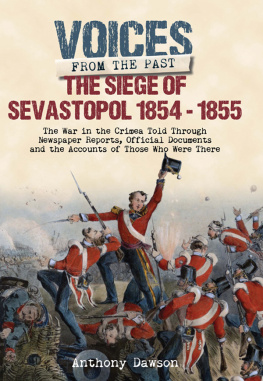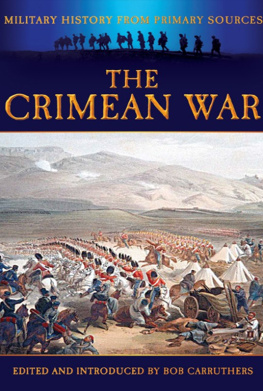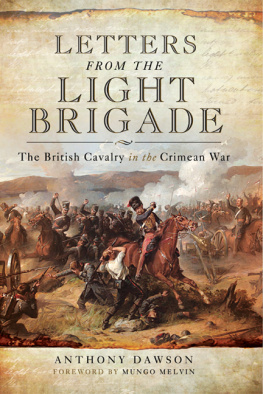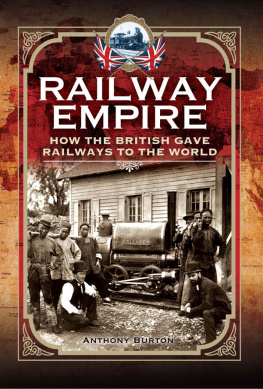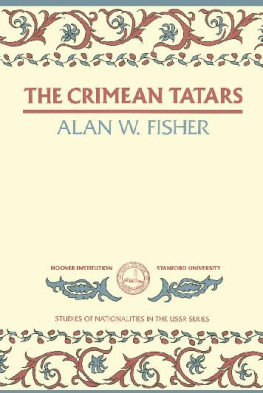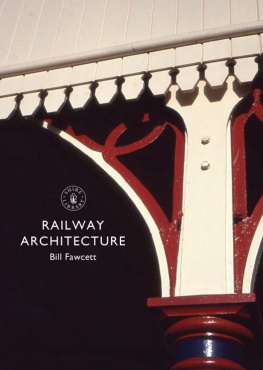Anthony Dawson - The Railway That Helped Win the Crimean War: The Story of the Grand Crimean Central Railway
Here you can read online Anthony Dawson - The Railway That Helped Win the Crimean War: The Story of the Grand Crimean Central Railway full text of the book (entire story) in english for free. Download pdf and epub, get meaning, cover and reviews about this ebook. year: 2022, publisher: Frontline Books, genre: History. Description of the work, (preface) as well as reviews are available. Best literature library LitArk.com created for fans of good reading and offers a wide selection of genres:
Romance novel
Science fiction
Adventure
Detective
Science
History
Home and family
Prose
Art
Politics
Computer
Non-fiction
Religion
Business
Children
Humor
Choose a favorite category and find really read worthwhile books. Enjoy immersion in the world of imagination, feel the emotions of the characters or learn something new for yourself, make an fascinating discovery.
- Book:The Railway That Helped Win the Crimean War: The Story of the Grand Crimean Central Railway
- Author:
- Publisher:Frontline Books
- Genre:
- Year:2022
- Rating:4 / 5
- Favourites:Add to favourites
- Your mark:
- 80
- 1
- 2
- 3
- 4
- 5
The Railway That Helped Win the Crimean War: The Story of the Grand Crimean Central Railway: summary, description and annotation
We offer to read an annotation, description, summary or preface (depends on what the author of the book "The Railway That Helped Win the Crimean War: The Story of the Grand Crimean Central Railway" wrote himself). If you haven't found the necessary information about the book — write in the comments, we will try to find it.
Anthony Dawson: author's other books
Who wrote The Railway That Helped Win the Crimean War: The Story of the Grand Crimean Central Railway? Find out the surname, the name of the author of the book and a list of all author's works by series.
The Railway That Helped Win the Crimean War: The Story of the Grand Crimean Central Railway — read online for free the complete book (whole text) full work
Below is the text of the book, divided by pages. System saving the place of the last page read, allows you to conveniently read the book "The Railway That Helped Win the Crimean War: The Story of the Grand Crimean Central Railway" online for free, without having to search again every time where you left off. Put a bookmark, and you can go to the page where you finished reading at any time.
Font size:
Interval:
Bookmark:
The Railway that
Helped win the
Crimean War
The Railway that
Helped win the
Crimean War
The Story of the Grand Crimean Central Railway
ANTHONY DAWSON


THE RAILWAY THAT HELPED WIN THE CRIMEAN WAR
The Story of the Grand Crimean Central Railway
First published in Great Britain in 2022 by
Frontline Books
An imprint of
Pen & Sword Books Ltd
Yorkshire Philadelphia
Copyright Anthony Dawson, 2022
ISBN 978 1 52677 555 9
eISBN 978 1 52677 556 6
Mobi ISBN 978 1 52677 556 6
The right of Anthony Dawson to be identified as the author of this work has been asserted by him in accordance with the Copyright, Designs and Patents Act 1988.
A CIP catalogue record for this book is available from the British Library
All rights reserved. No part of this book may be reproduced or transmitted in any form or by any means, electronic or mechanical including photocopying, recording or by any information storage and retrieval system, without permission from the Publisher in writing.
Pen & Sword Books Ltd incorporates the Imprints of Aviation, Atlas, Family History, Fiction, Maritime, Military, Discovery, Politics, History, Archaeology, Select, Wharncliffe Local History, Wharncliffe True Crime, Military Classics, Wharncliffe Transport, Leo Cooper, The Praetorian Press, Remember When, Seaforth Publishing and Frontline Publishing.
For a complete list of Pen & Sword titles please contact
PEN & SWORD BOOKS LTD
47 Church Street, Barnsley, South Yorkshire, S70 2AS, England
E-mail: enquiries@pen-and-sword.co.uk
Website: www.pen-and-sword.co.uk
Or
PEN AND SWORD BOOKS
1950 Lawrence Rd, Havertown, PA 19083, USA
E-mail: Uspen-and-sword@casematepublishers.com
Website: www.penandswordbooks.com
The writing of a book is never a solo task, even though at many times it may feel like it. Firstly, I should like to thank my partner, Andy Mason, for his continued support of my writing endeavours and accompanying me on research trips across the country. Secondly, to colleagues in Russia and in Turkey: Vladimir Serdiuk a PhD Student in Moscow for searching for Russian sources, and Yunus Emre Adin for accessing Turkish archives in Istanbul concerning the sale of the Balaklava Railway. To them I shall be eternally gratefully. Thirdly, to Dr Stephen Summerfield for proofreading and editing this text.
The advent of then new technologies, use of the telegraph network and photography, allowed harrowing stories and images of the terrible conditions endured by the army in the Crimean War to reach the breakfast-table newspapers of their readers back home. The publics increasingly hostile opinion of the war eventually forced the government of the day to act and this became the catalyst for change that led to the modernisation of logistic services within the army.
The British armys shortages of equipment and the privations under which it struggled during the Crimean War managed to transform the way the army sustained itself in the field. These difficulties paved the way for major changes in how Parliament governed the army, together with the creation of new responsibilities for procurement, supply and transport with many of these changes remaining broadly recognisable and enabling todays Royal Logistic Corps soldier to trace their history in an unbroken line back to the Land Transport Corps soldiers then raised.
This book describes the momentous Crimean War events in clear detail, explaining how the British army was sustained, before, during and after the war, and showing just how challenging these changes were in their delivery. Further, it explains the armys need to improve the capability and resilience of its supply line and, thus, why a purpose-built railway was constructed, detailing how it was funded, erected, operated and ultimately how effective it was.
Additionally, this book compares the British armys method of supply with that of the French, enabling the reader to contrast the two approaches and draw conclusions on their relative values. This book will be rewarding, not only to the serious scholar who seeks an in-depth analysis of the changes as they unfolded, but also to the more casual reader with perhaps a lighter interest in the subject.
Anthony Dawson should be congratulated for capturing this story brilliantly, with his evident use of extensive research from primary sources as well as from a wide range of historical and contemporary references. It is thoroughly researched and well executed, easy to read and logically laid out.
The Royal Logistic Corps Museum tells the story of army logistics from medieval times to the present day. One of the key milestones on this extensive journey is the Crimean War.
Simon Walmsley has been the Director of The Royal Logistic Corps Museum since 2016. He initially saw service with the Royal Artillery and subsequently joined the Royal Logistic Corps on its formation in 1993. During his thirty-two-year military career, he deployed to the Falklands War in 1982 and also saw service in Bosnia, Kosovo, Iraq and Afghanistan. He holds a Masters degree in Business Administration and a second Masters degree in Museum Studies.
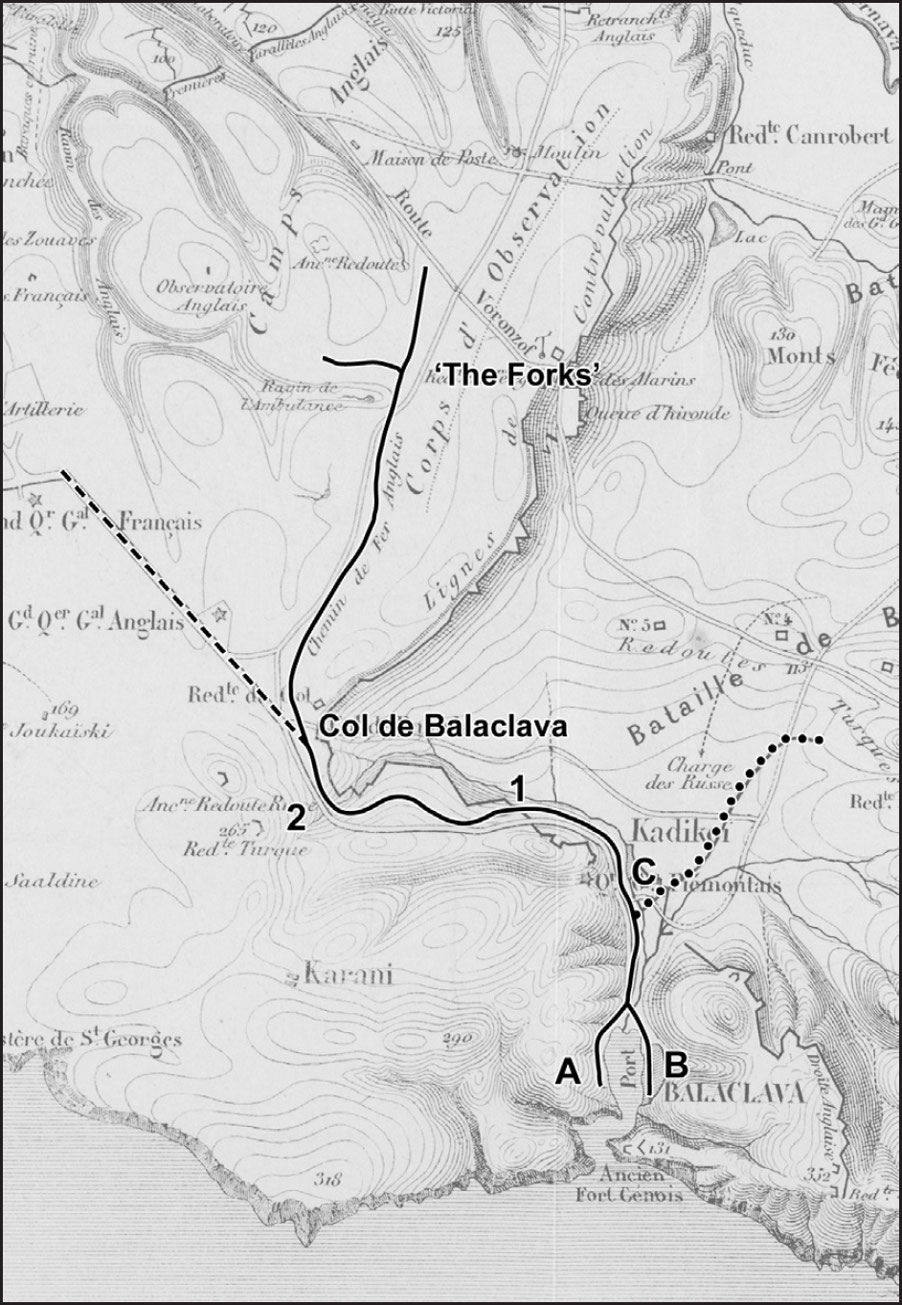
The Grand Crimean Central Railway, showing the main line and French (dashed) and Piedmontese (dotted) branches. The line was worked by locomotives from Diamond Wharf (A) and Ordnance Wharf (B) to the Commissariat Depot at Kadikoi (C) before making its way up the heights via two inclined planes. (1) Powered incline of 1:15, (2) Horse-worked incline of 1:25. From the Col de Balaclava the line was worked by horses. (Andrew Mason)
The Crimean War was fought between 1854 and 1856 by an alliance of Great Britain, France, Piedmont-Sardinia and Turkey against Russia. It was characterised by the eleven-month siege of the Russian naval base of Sevastopol. It was the first modern war; not just in terms of its scale the French army mobilised a million men but also the technologies employed, seeing the mass use of rifled muskets and artillery for the first time, the electric telegraph, the typewriter, steam ships, iron clads and, for this study, the steam railway.
Distrust of Russia and her ambitions in the Near East had rumbled throughout the 1820s and 1840s. Considered land-hungry and reactionary, the Russo-Turkish War of 18278 produced the spectre of Russian control of Constantinople and the eastern Mediterranean. The trigger for war with Russia finally came in 1852 over the issue of the keys to the Holy Places of Jerusalem. Since the Middle Ages France had claimed the right of guardianship of the Holy Places: the Church of the Nativity in Bethlehem and the Church of the Holy Sepulchre in Jerusalem. During the French Revolution and Napoleonic Wars this claim had gradually been allowed to lapse and Russia which viewed itself as not only the champion of the Orthodox Church but also the Slavic people assumed the mantle of guardian. Thus, when Napolon III (180874, r. 185170) renewed the traditional French claim of guardianship and had a silver star engraved with the Arms of France placed in the Church of the Nativity, Russia was outraged. Thanks to pressure from the French Ambassador, La Valette, and French warships, in November 1852 the Sublime Porte, ruler of the Ottoman Empire, granted France the right to hold the keys to the Holy Places. This was a policy that was supported in Britain and by the virulently anti-Russian British ambassador at Constantinople, Lord Stratford Canning.
Next pageFont size:
Interval:
Bookmark:
Similar books «The Railway That Helped Win the Crimean War: The Story of the Grand Crimean Central Railway»
Look at similar books to The Railway That Helped Win the Crimean War: The Story of the Grand Crimean Central Railway. We have selected literature similar in name and meaning in the hope of providing readers with more options to find new, interesting, not yet read works.
Discussion, reviews of the book The Railway That Helped Win the Crimean War: The Story of the Grand Crimean Central Railway and just readers' own opinions. Leave your comments, write what you think about the work, its meaning or the main characters. Specify what exactly you liked and what you didn't like, and why you think so.


